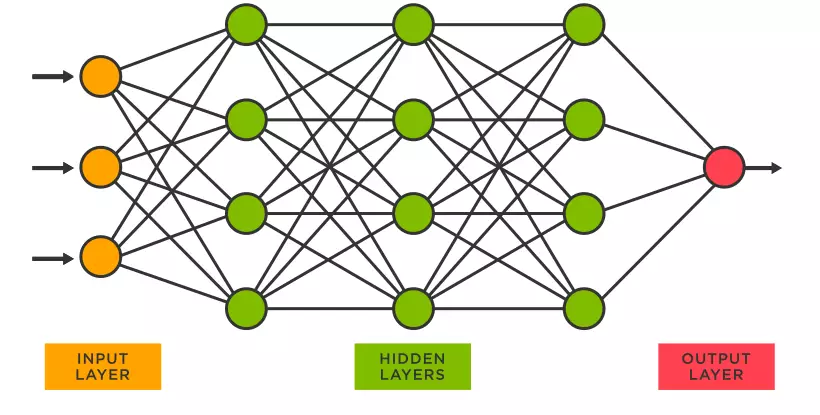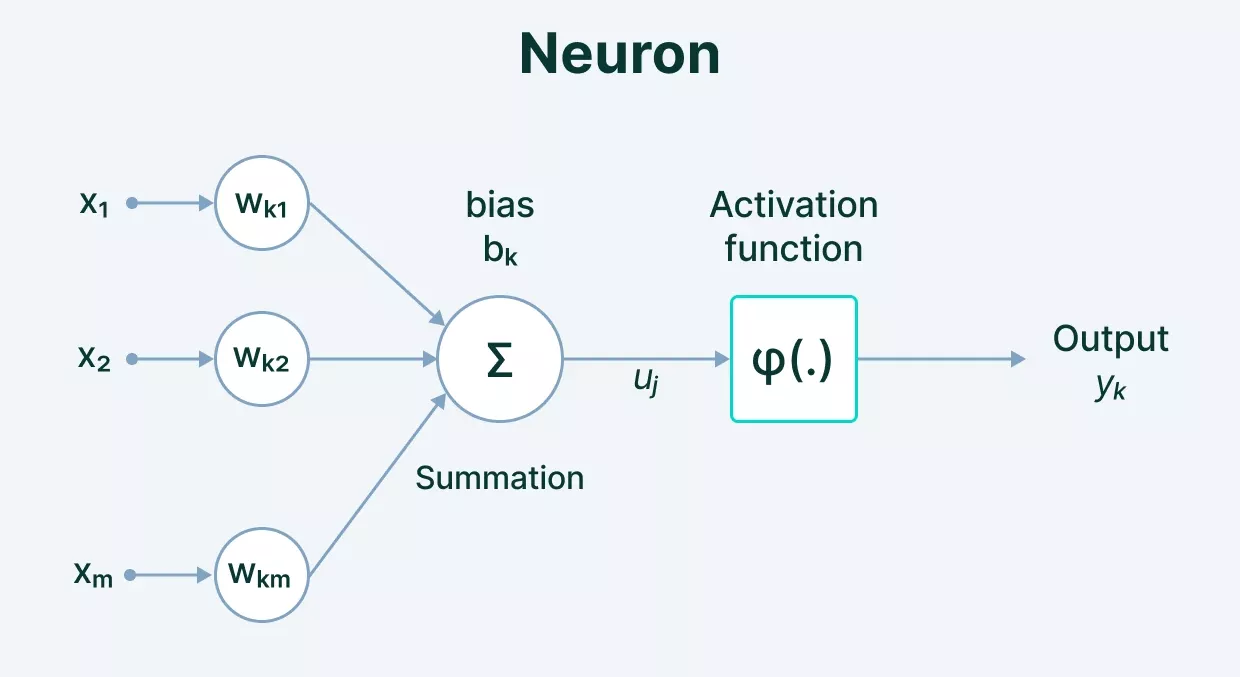神经网络 neural network
神经网络由多个神经元互相连接组成,每个神经元是一个计算单元,位于同一层级的多个神经元组成一个网络层。一般的神经网络一般由三种网络层组成:输入层,隐藏层和输出层。

神经网络的组成
- 激活函数 Activatioin Functioin
神经元的输入经过激活函数得到输出,激活函数的输出值定义了神经元是否被激活。激活函数有几种不同的形式,它的选取取决于期望的神经元输出。
- Binary 输入为正数时神经元输出1,输入为负数时神经元输出0
$$
f(x)= \small\begin{cases} 0, & \text{if } x < 0 \newline 1, & \text{if } x\geq 0 \end{cases}
$$
- Sigmod 由输入值得到0和1之间的连续输出值
$$
f(x) = {\large \frac{1}{1+e^{-x}}}
$$
- Tanh 由输入值得到-1和1之间的连续输出值
$$
f(x) = {\large \frac{e^{x} - e^{-x}}{e^{x} + e^{-x}}}
$$
- ReLU 当输入为负数时输出为0,输入为正数时保持输入值
$$
f(x)= \small \begin{cases} 0, & \text{if } x < 0\newline x, & \text{if } x\geq 0 \end{cases}
$$
- 权重 Weights
由前一神经元输出到下一神经元输入的加权
- 偏置 Bias

$$
output=activation function(\sum{(weights * inputs) + bias})
$$在PyTorch中建立神经网络
torch.nn提供了建立神经网络需要的组件,在PyTorch中神经网络是一个module,一个神经网络由多个同样是module的网络层组成。所有的神经网络模型都是nn.Module的子类。
1
2
3
4
5
6
7
8
9
10
11
12
13
14
15
16
17
18
19
20
21
22
23
24
25
26
27
28
|
import os
import torch
from torch import nn
from torch.utils.data import DataLoader
from torchvision import datasets, transforms
device = 'cuda' if torch.cuda.is_available() else 'cpu'
print('Using {} device'.format(device))
class NeuralNetwork(nn.Module):
def __init__(self):
super(NeuralNetwork, self).__init__()
self.flatten = nn.Flatten()
self.linear_relu_stack = nn.Sequential(
nn.Linear(28*28, 512),
nn.ReLU(),
nn.Linear(512, 512),
nn.ReLU(),
nn.Linear(512, 10),
nn.ReLU()
)
def forward(self, x):
x = self.flatten(x)
logits = self.linear_relu_stack(x)
return logits
model = NeuralNetwork().to(device)
|
通过向模型传递输入数据,模型会自动调用forward(),并返回模型输出。
1
2
3
4
5
|
X = torch.rand(1, 28, 28, device=device) # 生成模型输入数据
logits = model(X) # 向模型传递输入数据,model.forward()自动执行,得到输出logits
pred_probab = nn.Softmax(dim=1)(logits)
y_pred = pred_probab.argmax(1)
print(f"Predicted class: {y_pred}")
|
nn.Linear
nn.Linear随机初始化每层的权重和偏置,并储存在tensors中
nn.Flatten
nn.Flatten将28x28的图片转换为一个784维的输入向量
nn.Sequential
nn.Sequential是一个module的容器,数据经过nn.Sequential后,会按照定义时的顺序,依次进行运算。
1
2
3
4
5
6
7
8
9
10
|
self.linear_relu_stack = nn.Sequential(
nn.Linear(28*28, 512),
nn.ReLU(),
nn.Linear(512, 512),
nn.ReLU()
)
logits = self.linear_relu_stack(x)
# x输入linear_relu_stack后,依次经过module nn.Linear(28*28, 512),
# nn.ReLU(),nn.Linear(512, 512),nn.ReLU()
|
nn.ReLU
激活函数ReLU
模型参数
神经网络的参数包括每一个网络层的weight和bais,通过模型的parameters()或named_parameters()可以获取模型中的所有参数
1
2
3
4
|
print("Model structure: ", model, "\n\n")
for name, param in model.named_parameters():
print(f"Layer: {name} | Size: {param.size()} | Values : {param[:2]} \n")
|


